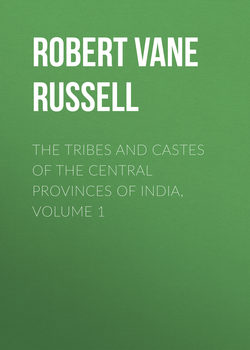Читать книгу The Tribes and Castes of the Central Provinces of India, Volume 1 - Robert Vane Russell - Страница 59
Part I.
Introductory Essay on Caste
Introductory Essay on Caste
56. Concrete nature of primitive ideas
ОглавлениеThe primitive languages consisted only of nouns or the names of visible objects, possibly with the subsequent addition of a few names for such conceptions as the wind and the voice, which could be heard, but not seen. There were no abstract nor semi-abstract terms nor parts of speech. The resulting inability to realise any abstract conception and the tendency to make everything concrete is a principal and salient characteristic of ethnology and primitive religion.111 All actions are judged by their concrete aspect or effects and not by the motives which prompted them, nor the results which they produce. For a Hindu to let a cow die with a rope round its neck is a grave caste offence, apparently because an indignity is thus offered to the sacred animal, but it is no offence to let a cow starve to death. A girl may be married to inanimate objects as already seen, or to an old man or a relative without any intention that she shall live with him as a wife, but simply so that she may be married before reaching puberty. If she goes through the ceremony of marriage she is held to be married. Yet the motive for infant-marriage is held to be that a girl should begin to bear children as soon as she is physically capable of doing so, and such a marriage is useless from this point of view. Some castes who cannot afford to burn a corpse hold a lighted brand to it or kindle a little fire on the grave and consider this equivalent to cremation. Promises are considered as concrete; among some Hindus promises are tied up in knots of cloth, and when they are discharged the knots are untied. Mr. S.C. Roy says of the Oraons: “Contracts are even to this day generally not written but acted. Thus a lease of land is made by the lessor handing over a clod of earth (which symbolises land) to the lessee; a contract of sale of cattle is entered into by handing over to the buyer a few blades of grass (which symbolise so many heads of cattle); a contract of payment of bride-price is made by the bridegroom’s father or other relative handing over a number of baris or small cakes of pulse (which symbolise so many rupees) to the bride’s father or other relative; and a contract of service is made by the mistress of the house anointing the head of the intended servant with oil, and making a present of a few pice, and entertaining him to a feast, thus signifying that he would receive food, lodging and some pay.”112 Thus an abstract agreement is not considered sufficient for a contract; in each case it must be ratified by a concrete act.
Gāyatri or sacred verse personified as a goddess
The divisions of time are considered in a concrete sense. The fortnight or Nakshatra is presided over by its constellation, and this is held to be a nymph or goddess, who controls events during its course. Similarly, as shown in The Golden Bough,113 many kinds of new enterprises should be begun in the fortnight of the waxing moon, not in that of the waning moon. Days are also thought to be concrete and governed by their planets, and from this idea come all the superstitions about lucky and unlucky days. If a day had been from the beginning realised as a simple division of time no such superstitions could exist. Events, so far as they are conceived of, are also considered in a concrete sense. The reason why omens were so often drawn from birds114 is perhaps that birds fly from a distance and hence are able to see coming events on their way; and the hare and donkey were important animals of augury, perhaps because, on account of their long ears, they were credited with abnormally acute hearing, which would enable them to hear the sound of coming events before ordinary people. The proverb ‘Coming events cast their shadows before,’ appears to be a survival of this mode of belief, as it is obvious that that which has no substance cannot cast a shadow.
The whole category of superstitions about the evil eye arises from the belief that the glance of the eye is a concrete thing which strikes the person or object towards which it is directed like a dart. The theory that the injury is caused through the malice or envy of the person casting the evil eye seems to be derivative and explanatory. If a stranger’s glance falls on the food of a Rāmānuji Brāhman while it is being cooked, the food becomes polluted and must be buried in the ground. Here it is clear that the glance of the eye is equivalent to real contact of some part of the stranger’s body, which would pollute the food. In asking for leave in order to nurse his brother who was seriously ill but could obtain no advantage from medical treatment, a Hindu clerk explained that the sick man had been pierced by the evil glance of some woman.
111
See also Primitive Culture, i. p. 408.
112
The Oraons, pp. 408, 409.
113
2nd ed. vol. ii. p. 457 et seq.
114
For instances of omens see article Thug and Index. Also Miss Harrison’s Themis, pp. 98, 99.
